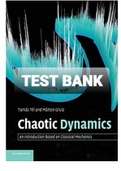,CUUK255-Tell Et al June 9, 2006 16:45
Solutions to the problems1
Solution 2.2 Let the area of the largest regular triangle inscribed into the island be
A0 , which is also the area in the zeroth step of the Koch construction. In the first
step, three smaller triangles are added, with an area of A0 /9 each. In the nth step,
the number of new triangles of area A0 /9n is 3 × 4n−1 . The total area of all the
� �
small triangles is therefore A0 ∞ n=1 3 × 4 9 = A0 /3 ∞
n−1 −n n
n=0 (4/9) . This is a
geometrical series of quotient 4/9. Thus, the area increment is finite:
A0 /(3(1 − 4/9)). The total area of the Koch island is (8/5)A0 .
Solution 2.4 D0 = ln 3/ ln 2 = 1.585.
Solution 2.5 (a) D0 = ln 4/ ln (1/r ); (b) D0 = ln 3/ ln 2 = 1.585;
(c) D0 = ln 5/ ln 3 = 1.465.
Solution 2.7 (a) D0 = ln 20/ ln 3 = 2.727; (b) D0 = 2.
Solution 2.8 With r2 = r12 , the only positive solution of the quadratic equation
√
r1D0 + r12D0 = 1 is D0 = ln[( 5 − 1)/2]/ ln r1 , which yields, for r1 = 1/2,
D0 = 0.694.
Solution 2.9 The fractal can be decomposed into five similar parts. Four of these
are identical to the entire fractal reduced by a factor of r1 = 2/5, while the
reduction factor for the fifth part is r2 = 1/5. The equation for the dimension is
therefore 4(2/5) D0 + (1/5) D0 = 1, yielding D0 = 1.601.
Solution 2.14 The area (volume) of the preserved rectangles in the nth step is
Vn = �nj=1 (1 − λ2 j ). (Its limiting value for λ = 0.6 is V = 0.517.) The smallest
distance occurring in this step is the size of the holes in the squares situated at the
� � −n+1
corners of the original square, ε = λn π n−1j=1 (1 − λ ) 2
j
; we therefore cover the
set with intervals of this size. In analogy with the solution of Problem 2.13, we find
that α = 2 ln λ/ln (λ/2). With λ = 0.6, α = 0.849.
Solution 2.16 See Fig. 1. The possible box probabilities are again pm = p1m p2n−m ,
� �
m = 0, 1, ..., n. The number of boxes carrying pm at level n is Nm = 2m mn (the
total number of the boxes is 3n ). The logarithm of the total probability, Nm pm , is,
1 These are the solutions which do not appear in the book.
1
, CUUK255-Tell Et al June 9, 2006 16:45
2 Solutions to the problems
P(x)
15
10
5
x
Fig. 1. Distribution after the seventh step of construction. Similarly to Fig. 2.15
the typical intervals are shown under the graph, and the height of the columns
on these typical intervals is marked by a dashed line. (The continuous support is
not displayed, and only part of the central peak, of height 61.2, is visible.)
according to Stirling’s formula,
ln (Nm pm ) = n ln n − m ln m − (n − m) ln (n − m) + m ln 2 + m ln p1
+ (n − m) ln p2 .
The extremum belongs to a value m ∗ = 2np1 . The number of such boxes is
N ∗ ≡ Nm ∗ , leading to ln N ∗ = −n(2 p1 ln p1 + p2 ln p2 ). Since the resolution at
level n is ε = 3−n ,
2 p1 ln p1 + p2 ln p2
D1 = − .
ln 3
This is always less than unity for p1 �= 1/3, and it is smaller, the smaller p1 is. The
same result follows from definition (2.18) by writing it as N ∗ pm ∗ ln pm ∗ = D1 n ln 3,
since N ∗ pm ∗ = 1.
Solution 3.1 The point mass moves tangentially. Since the tangent forms a slope
of inclination ϕ (see Fig. 3.1), the tangential acceleration is given by g sin ϕ, where
g is gravitational acceleration. This is, at the same time, the peripheral acceleration,
l ϕ̈; the Newtonian equation is therefore given by l ϕ̈ = g sin ϕ. For small ϕ, the sine
can be approximated by its argument, and the equation becomes ϕ̈ = (g/l)ϕ, which
√
is of the same type as equation (3.2), with repulsion parameter s0 = g/l.




